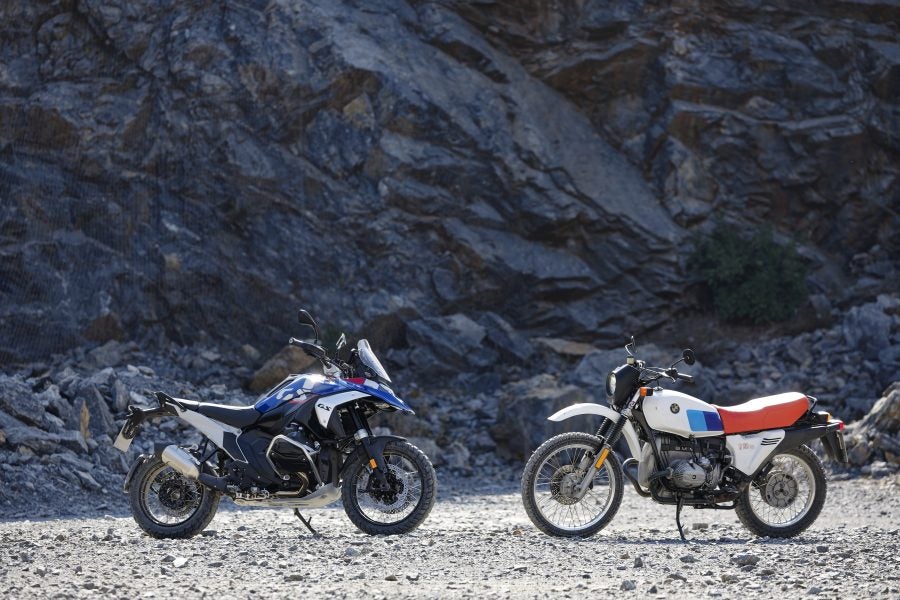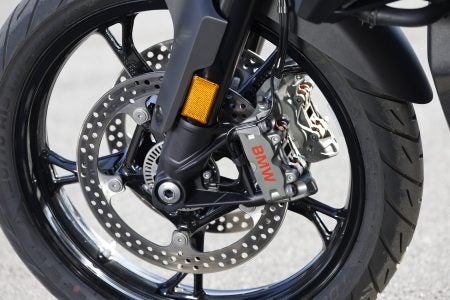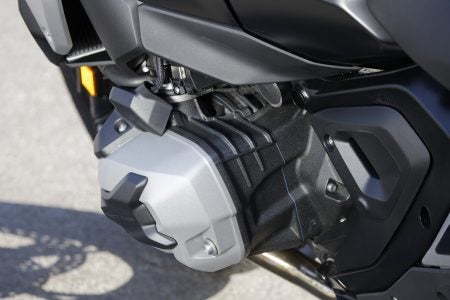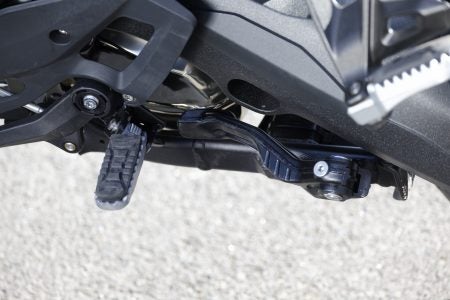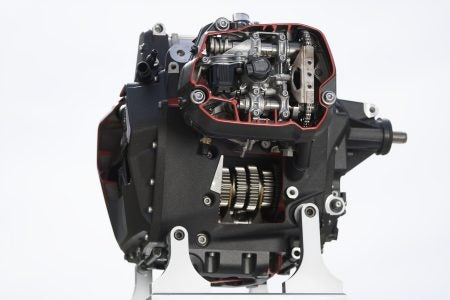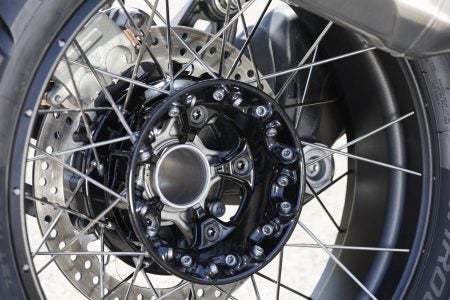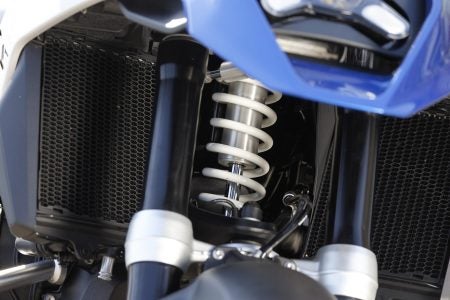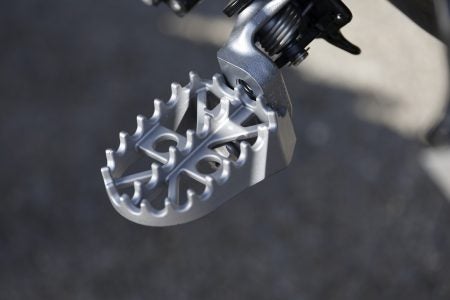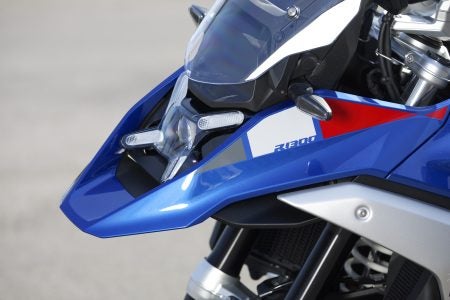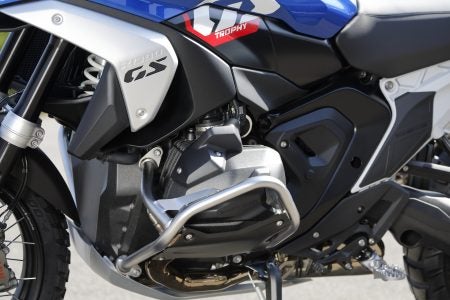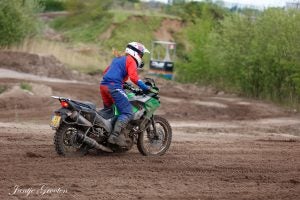I have a relatively long history with BMW’s big GS. I once owned a 1986 R80 G/S, which I had bought new that year. The bike was actually introduced in 1980, and what set it apart from all other dual-purpose bikes of the day was its 800 cc boxer twin. The big (for the time) engine made the bike a much better road tourer than the big singles of the day, making it the undisputed grandfather of all adventure bikes.
My ’86 model was six years into its life cycle, yet it was nearly identical to the original — changes came at a much slower pace back in the early 1980s. There were also very few variations; in ’86 you could get the standard G/S, or my bike, the Paris-Dakar version, with a larger 32-litre fuel tank, a solo seat and a luggage rack.
Forty-four years and several generations later, evolution has produced the most radically redesigned, and the most potent GS ever: the 2024 R1300GS. We flew to Malaga, Spain, where we spent time on and off the road on BMW’s big ADV bike, and learned that while it’s still very much a GS, it is a very different GS.
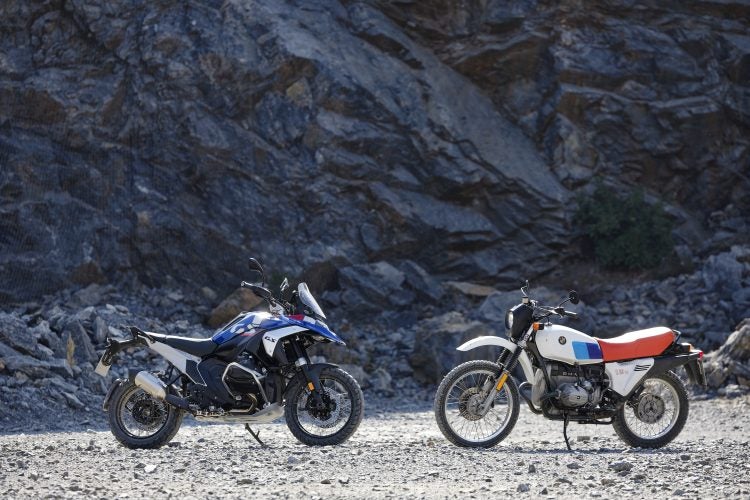
The old and the new; the OG R80 G/S on the right, the new R1300 GS on the left. Photo: BMW
An entirely new boxer twin
As its moniker suggests, the GS’s liquid-cooled boxer has grown in displacement from 1,254 cc to 1,300 cc, via a larger bore, but a shorter stroke (106.5 x 73mm vs. 102.5 x 76mm), though it has the same 9,000-rpm rev limit. The engine is 8.6 lb. (3.9 kg) lighter, and to improve the engine’s weight distribution, while also giving it a symmetrical appearance (boxer cylinders are inherently offset), the left cylinder has its cam drive at the rear, and the right cylinder at the front. The valve train still features BMW’s ShiftCam technology, which enables variable timing and lift on the intake valves, thus broadening torque delivery. Intake and exhaust valves are bigger, now measuring 44 and 35.6mm (previously 40 and 34mm). The compression ration is also higher, at 13.3:1 from 12.5:1.
Output is now 143 horsepower and 109.9 lb.-ft. of torque, an increase of 9 hp and 4.4 lb.-ft. over the R1250GS, making this the most powerful production boxer ever made. It actually feels more powerful than those numbers would suggest, because the bike has lost 26.5 lb. (12 kg), now weighing 523 lb. (237 kg) wet, though fuel tank capacity has dropped .25 gallon to 5 gallons to help achieve that number.
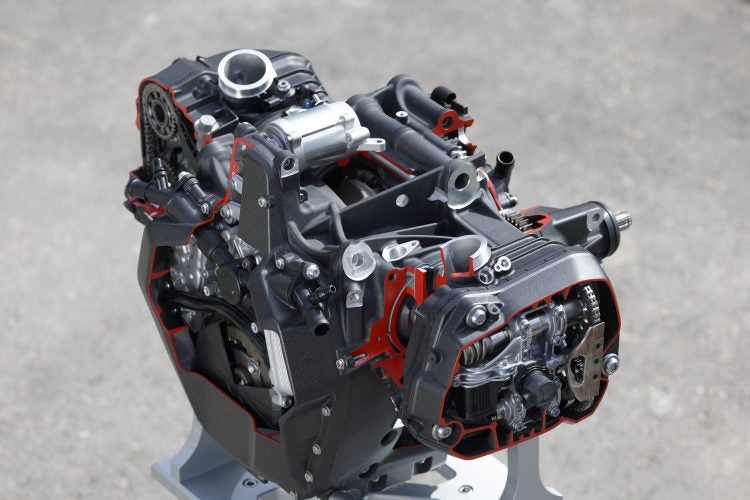
The big redesign starts with BMW’s new 1300, the most powerful flat twin ever made. Photo: BMW
One big change within its engine cases is with the six-speed gearbox, which has been relocated from its traditional location behind the engine, to below the engine. This makes for a remarkably compact powerplant, and it lowers the center of gravity. Gear ratios for first through fourth are the same; fifth and sixth are taller. Power transfers to the gearbox via a wet slipper clutch.
At first glance it looks like an aluminum frame had replaced the tubular-steel frame of the R1250 GS, but the new one is actually made from stamped steel pieces that are welded together and fully boxed, producing a more compact, more streamlined, and stiffer unit. The old tubular-steel subframe has been replaced by a more rigid die-cast aluminum piece that is lighter, is more rigidly secured to the main frame, and offers more mounting possibilities for accessories. Its monocoque design should be more resistant to breakage, which the steel subframe was prone to do when overloaded by overly ambitious travelers.
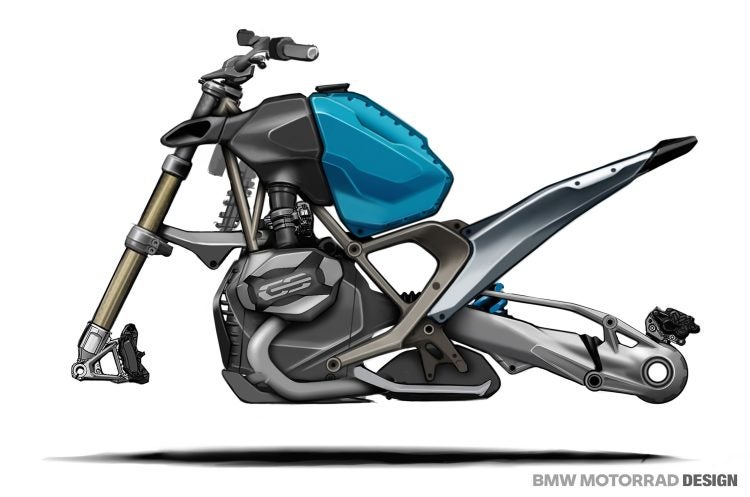
An updated frame and subframe is supposed to be stronger with all-new design, and new materials. Image: BMW
The frame and subframe flow into the bodywork more fluidly, and components that were bolted-on assemblies — like the headlamp assembly, for example — are now integrated into the bike, giving it a much more coherent, streamlined silhouette. There is a variety of luggage racks, grab handles, and passenger seats that allow you to have a narrow, minimalist rear end, or one that is fully decked out for two, with side cases and a top case.
Revised suspension
The suspension, too, has been redesigned, and there are four variations available. There’s the standard suspension that’s manually adjustable for rear spring preload, the electronically adjustable DSA suspension, the new adaptive height-control DSA suspension, which drops the bike 1.2 inches (30mm) at both ends when rolling to a stop, and raises it once rolling above 15 mph to regain ground clearance, and the Sport DSA suspension, which has 0.8 inches (20mm) more travel than the other options for serious off-roaders. Like the ESA suspension it replaces, the new DSA adjusts damping settings electronically based on the selected ride mode, but it differs in that it now adjusts preload electrically at both ends, rather than just at the rear.
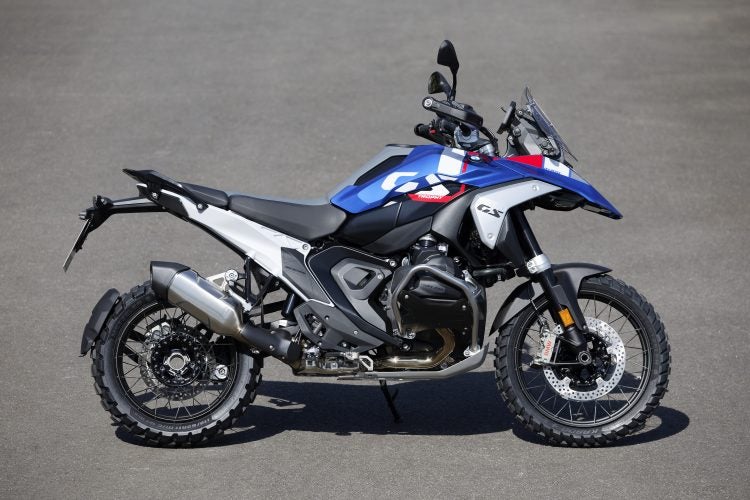
Updated suspension auto-adjusts fore and aft. Photo: BMW
Another big suspension change is at the front end. BMW is the only manufacturer of mass-produced motorcycles to use an alternative to the conventional fork. The company has been using the Telelever system for about three decades, and it comprises a pair of telescopic forks mounted to an A-arm-like swingarm, with damping and springing duties provided by an external shock absorber. Its inherent design sees some forward and backward movement of the front wheel as it moves up and down over bumps. To compensate for this fore and aft movement, spherical bearings are needed where the top of fork tubes are attached to the tripleclamp. This design reduces the torsional rigidity of the front end, allowing for some twist.
To greatly increase front-end rigidity — and consequently steering response and feedback — fork-tube diameter has been increased to from 37mm to 45, and the tubes are now rigidly mounted to the top fork clamp, without the bearings. To compensate for fore-and-aft movement, a single, larger spherical bearing is now mounted at the center of the top clamp, at the steering stem. This system now allows the entire top clamp to pivot slightly as the front wheels travels up and down, but makes for a much more rigid suspension assembly torsionally.

The new front end design borrows ideas from some of BMW’s high-performance street bikes of the past. Photo: BMW
To prevent the handlebar from pivoting with the top clamp, it is mounted rigidly to the center of the fork stem, with a flat, triangulated spring plate transferring steering inputs to the fork clamp. Now called Evo Telelever, the system is very similar to the one used on a couple of BMW’s past sport bikes, namely the R1100S and the HP2 Sport. Adding even more front-end stiffness is a larger-diameter, 25mm wheel axle (up from 20mm) that is also lighter.
Ergonomics
The rear of the fuel tank is not as steeply angled as before, providing a roomier cockpit. A convenient compartment sits atop the fuel tank for your phone, and includes a USB port. The bike is narrower between the legs when seated, which makes the reach to the ground easier than before, and is beneficial when standing up off road. There’s also less of the bike visible in the rider’s view, which makes it easier to see obstacles just ahead of the bike at low speeds. A 6.5-inch TFT screen offers all the ride info and mode selection screens.
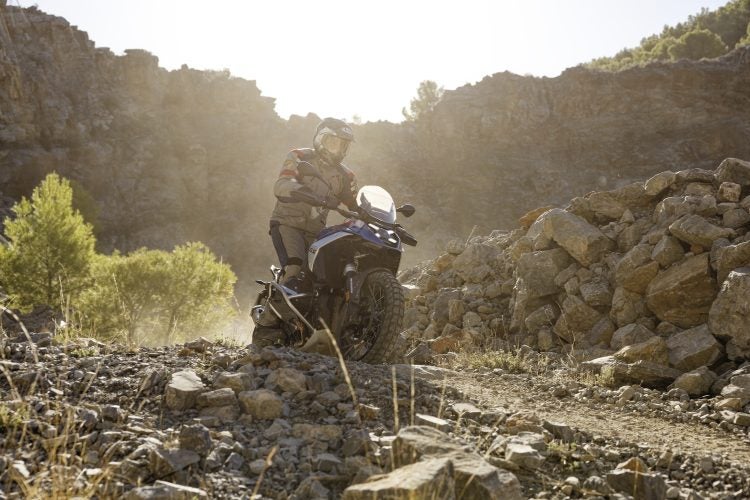
The seat is more narrow, which makes it easier to reach the ground, says Costa. And you can see more of the ground, too, with less bodywork obstructing your view. Photo: BMW
The standard footpegs have removable rubber inserts, under which they’re serrated for off-road grip. Optional, larger footpegs can be mounted in two positions for height, and the brake pedal pad can be flipped to a high or low position, for sitting or standing. There’s also an optional shorter-reach handlebar, as well as two riser inserts, one raising the handlebar 0.6 inches (15mm), one 1.2 inches (30mm).
The standard windscreen is small, but it can be flipped to a high or low position via a lever at the left of the gauges. An optional electrically adjusted screen is available (part of the $575 Comfort package). While the seat is adjustable for angle, it is no longer adjustable for height, though there are several optional seats of different heights available ($55 for any non-standard seat). Standard seat height is 33.5 in. (850mm), but depending on the chosen seat and suspension combination, seat heights vary from 31.5 to 35 inches (800 to 890mm).
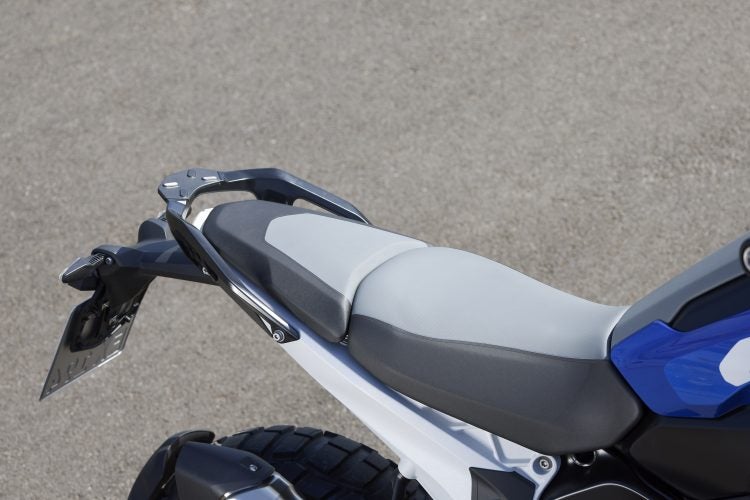
The seat is adjustable for angle, but not for height. Of course, accessory low seats are available. Photo: BMW
The bikes I rode were set to the standard height. The riding position is upright, though legroom is a bit tight with the standard seat — as a six-footer, I’d spring for the taller seat, which adds 0.8 inches (20mm) of height. Although I did not get an opportunity to ride a bike equipped with the height control suspension, I did take a seat on one that was lowered and had a low seat; its 31.5 in. (800mm) seat height put a comfortable bend in my knees with my feet on the ground.
Electrics
Even if you choose the base model, you get a good selection of standard features. Included are four ride modes (Rain, Road, Eco, Enduro), hill-hold control, adjustable, lean-sensing ABS and traction control, engine braking control, and cruise control. The bike also comes with a lightweight lithium battery and heated grips.
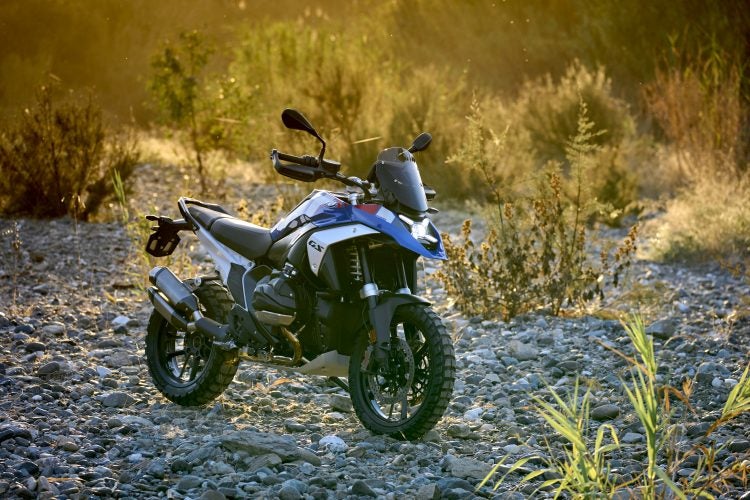
Even the base model has swank features like heated grips and a comprehensive electronics package. Photo: BMW
When it comes to options, well, the selection is vast. Among the items you can get within the various optional packages are a quick shifter, radar-enabled active cruise control (maintains a preset distance behind vehicles), blind-spot alert (a small warning light illuminates in the right or left mirror to warn of vehicles approaching from the rear), and front collision warning with brake intervention to help reduce the severity of a front-end collision.
There’s a standard LED headlight, but you can also get a brighter, adaptive LED headlight that illuminates corners when turning. Pro ride modes are available (Dynamic, Dynamic Pro and Enduro Pro), offering configurability and more aggressive settings than their standard equivalents. Other options include the aforementioned electrically adjustable windshield and suspension, and heated passenger and rider seats.
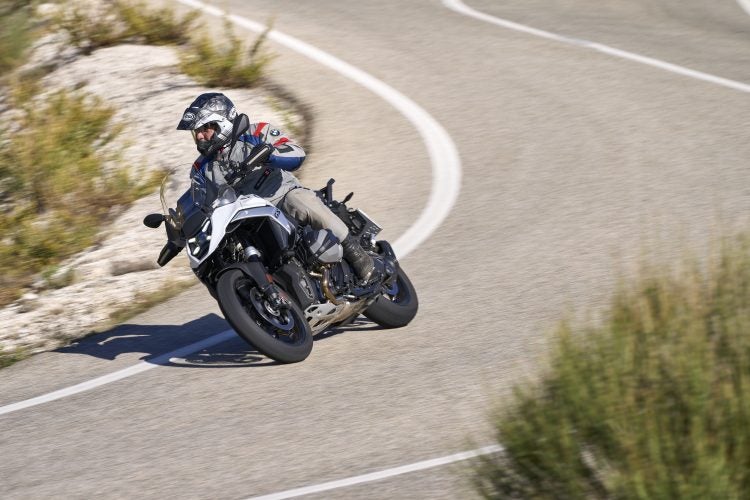
A cornering-sensitive headlight is optional. Photo: BMW
Although it’s not technically electric, a center stand is optional, and when combined with the adaptive height control, the bike will automatically rise when you drop the stand to facilitate propping it up. Another clever design feature is a folding foot lever that swings out of the way when the stand is retracted.
On the road
The bike I used for the road ride was equipped with the DSA suspension (without height control), a taller electrically adjustable windshield, Pro ride modes, and the electronic rider assists, and it rolled on the standard Metzeler Tourance 2 tires.
Moving out of the parking lot, I immediately noted that the new boxer engine was remarkably smooth, so much so that I can say confidently it is the smoothest twin I’ve ridden to date. Hitting the mountainous twisty roads outside of Malaga, it was no surprise that with the suspension firmed up in Dynamic mode, the GS handled like a sport bike.
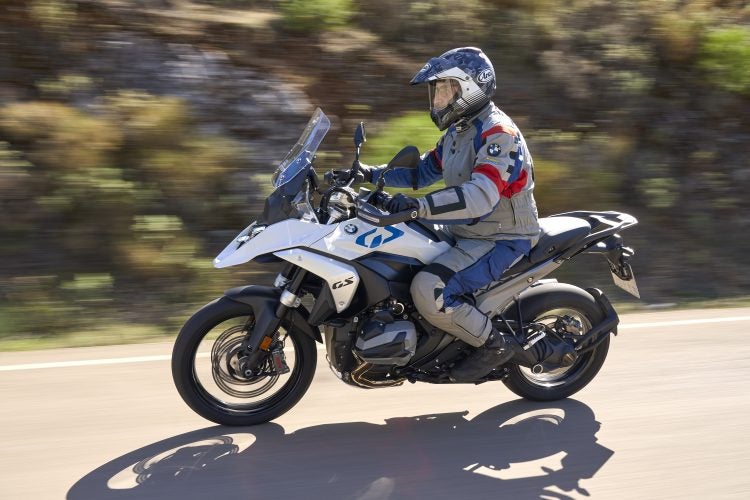
Just like previous GS models, the current 1300 has excellent handling. Costa goes so far as to compare it to a sportbike. Photo: BMW
You can charge aggressively into turns, staying hard on the brakes until well past the turn-in point. Even in the higher gears the boxer’s instantaneous torque blasts it out of corners. Steering is light, neutral and precise, and the bike holds a line with no further effort at the handlebar than the initial turn in. Suspension compliance is exemplary, keeping the bike planted through fast turns, yet soaking up sharp bumps without a trace of harshness — and that’s while adjusted to its firmest setting.
The bike definitely feels less top-heavy than before with the tank full, and transitions through esses confidently and quickly. Stability is unwavering whether you’re leaning hard into sweepers or riding at a 85 mph. Not only is the engine the smoothest twin I’ve ridden, but it revs quicker than before, and almost all traces of the sideways lurch experienced when blipping the throttle (a characteristic of a transversely mounted boxer), are gone. The engine has tons of low-end grunt, with a flat, wide spread of torque, and it continues pulling hard to redline. Passing at highway speeds doesn’t require a downshift.
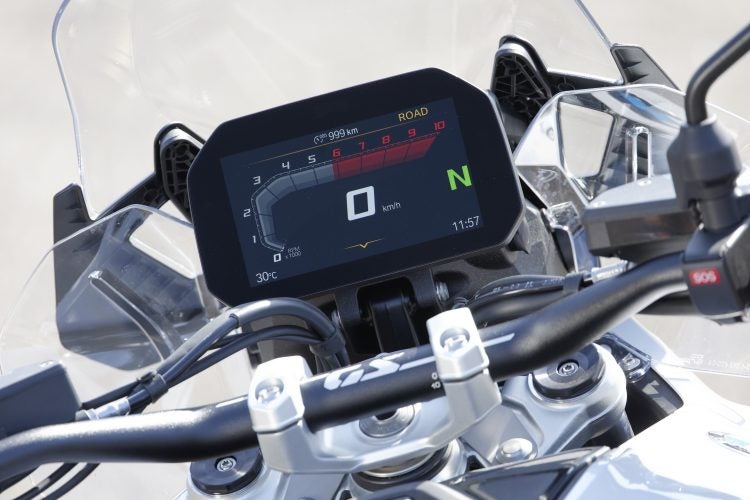
Of course, a TFT screen is standard, making it easy to keep track of your electronics’ settings. Photo: BMW
When the optional taller windshield is raised, wind protection is excellent; there’s no buffeting and the airflow is remarkably calm. With this setup the GS offers better wind protection than many dedicated touring bikes I’ve ridden, and is a big improvement over the previous model. The optional comfort seat remained comfy until we parked the bikes at the end of the day.
Off road
The next day we switched to bikes equipped with the GS Trophy package, DSA suspension, Pro ride modes, Enduro Pro package (off-road damage protection, risers, other off-road items), and the optional aggressively treaded Metzeler Karoo 4 tires.
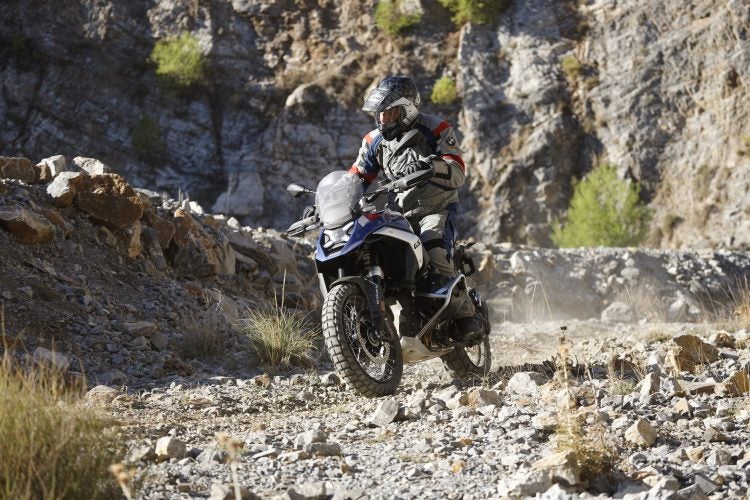
The new machine was familiar, but more narrow than the previous R1250 model, and lighter, all good things for off-roading. Costa liked the handlebar placement on the new model, too. Photo: BMW
We rode to an enduro park located inside a rock quarry, where we were treated to tight, rocky single-track trails, steep, rocky climbs and descents, and some faster dirt roads. We started oh some of the rocky trails, yet despite being rusty (I hadn’t ridden off road in a couple of months), I felt immediately comfortable standing on the pegs and pitching the GS around tight corners, over boulders, and under low-hanging branches. It felt immediately familiar, but lighter and narrower between the legs than the R1250GS. The handlebar risers also put the handlebar in a more comfortable position for me.
In Enduro Pro mode, with the suspension set softer than the default Enduro mode (Pro modes allow you to tailor various parameters), the bike soaked up big bumps without jolting the handlebar or bouncing off course. Steering was much more precise and stable over loose rock than the previous model, on which I have spent a lot of time. This improved response seems to validate the changes to the front suspension.
- Photo: BMW
- Photo: BMW
- Photo: BMW
- Photo: BMW
- Photo: BMW
- Photo: BMW
- Photo: BMW
- Photo: BMW
Many people wonder why BMW didn’t fit the GS with a 21/18-inch wheel combo, but the truth is it handles rough terrain quite handily on its 19-inch front and 17-inch rear, a combination that doesn’t sacrifice road handling for extreme off-road capability — the latter which isn’t really the bike’s forte, anyway.
What does affect road handling is the knobby Metzelers, which have very good grip on dirt and pavement, but on the latter they slow steering response considerably, reduce steering feel, and make the bike want to stand up in turns. If you plan a long trip off-road, install the Karoos; if you stick mostly to pavement, stick with the Tourance.
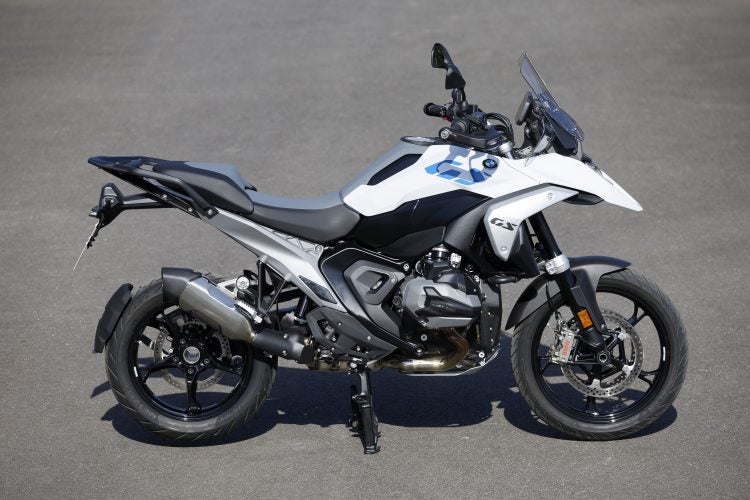
Even though there’s no Adventure variant launched or even announced yet, BMW’s wide range of 1300 models, plus the accessories package, allows you to get a machine that should meet your needs, whatever they are. Photo: BMW
So many choices
There are so many available options, packages and accessories, that you can certainly build an R1300 GS that fits you like a glove. This makes it difficult to access the bike in the time I spent on it, because there are so many possible variations. I’d take the tubeless spoke wheels, the Comfort package for the electrically adjustable windshield, the DSA suspension, and the Enduro package for all of the crash damage protection and handlebar risers. Pricing starts at $19,590, but you can spec your R1300GS to more than $26K if you tick all the boxes.
For now, this new platform is available only on the R1300 GS, and it is without a doubt, the best GS yet. The Adventure is still available for 2024, but it’s based on the previous R1250 GSA platform. Although there was no confirmation from BMW officials, it’s highly likely that an R1300 GSA will eventually be introduced, as will an R1300 RT. This platform is just too good and too much of an improvement for this not to happen.


